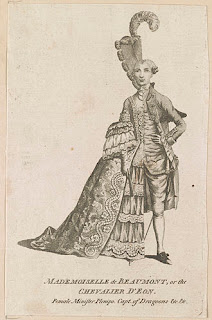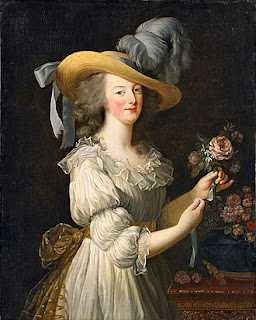By Nancy Bilyeau
It was the spring of 1810. Ordinarily, the death in London of an 81-year-old French émigré of aristocratic birth who'd long been living in genteel poverty would arouse little attention. The city was flooded with aristocrats during the French Revolution's Reign of Terror. Some of them never left.
But as the body of the deceased, known as the Chevalier d’Éon, was being prepared for burial, medical authorities swooped in to perform an investigation.
Its purpose? To answer a question that had been raised in society in the 1770s and persisted ever since, a debate that obsessed so many that the London Stock Exchange made it a betting-pool subject.
Was the Chevalier d’Éon a man or a woman?
 |
| Portrait made in 1792 |
Born on October 5, 1728, d’Éon’s full name was Charles-Geneviève-Louis-Auguste-André-Timothée d’Éon de Beaumont. The only son of Louis Deon de Beaumont--an advocate in Parliament, a King's Counsellor, and a member of the petite noblesse--he was raised in the elite, dissolute world of Dangerous Liaisons.
His duties extended beyond the crushing protocol of Versailles. France was a country often at war, and Louis XV struggled to make the right decisions in diplomatic and military matters. To better assist him, he split his diplomatic service in two: official and secret channels. Formed more than a century before MI6 in England, le Secret du Roi employed no more than 32 people at any time, undertaking missions in other countries vital to the interests of France.
His next assignment was to go to London in 1762, pretending to be a diplomat dealing with end-of-the-war issues like exchange of prisoners. Actually he was performing spy missions for Louis XV, such as learning of weaknesses in England’s defenses and conveying that information to Versailles. This was the time of invisible ink and ciphers. The French had suffered a bitter defeat, one that left England poised to dominate Europe as never before. Louis XV's directive to his spies was to "interfere with the ambitions of the English" as much as possible. (This resentment would lead to the famed French support of the British colonists in America in the 1770s.)
However, this was when the Chevalier and the French King had a falling out. He was jealous of a fellow diplomat and felt misunderstood and threatened. He threatened to expose Louis XV’s sexual secrets to the public unless he received a pension. After months of high drama, including an attempted poisoning and failed kidnapping, the pension flowed.
Around this time, his fondness for wearing women’s clothes and his androgynous appearance led to rumors that the Chevalier was, in fact, a woman biologically. The London Stock Exchange placed its question for wagers. He did not deny or confirm it.
 |
| A contemporary illustration showing the Chevalier's gender fluidity |
 |
| Fashion-conscious Marie Antoinette helped the Chevalier pay for a new wardrobe |
Biographer Gary Kates, who wrote Monsieur D'Eon Is a Woman, wrote that her sexual partners are unknown, whether in France, England, or Russia. There were never any marriages or public liaisons. Either she was extremely discreet or she did not have lovers.
"In today's context, the story of d'Éon divides historians," according to the ArtUK.org story "The Gender Fluidity of the Chevalier d'Éon." "While some regard d'Éon as a proto-'trans' figure, others such as Gary Kates refute this notion, arguing instead that they switched gender as part of a social and political strategy. The fascinating story of d'Éon raises questions about the role of gender in eighteenth-century Europe, indicating that perhaps a more open attitude about gender and sexual politics long preceded contemporary conversations about LGBTQ+ identities."
The French Revolution was unfriendly to aristocrats of any gender, and d’Éon made her way to England again. At first the Chevalier was as celebrated as ever. "It must indeed be acknowledged that she is the most extraordinary person of the age ... we have seen no one who has united so many military, political, and literary talents," according to The Annual Register for London.
The French Revolution was unfriendly to aristocrats of any gender, and d’Éon made her way to England again. At first the Chevalier was as celebrated as ever. "It must indeed be acknowledged that she is the most extraordinary person of the age ... we have seen no one who has united so many military, political, and literary talents," according to The Annual Register for London.
But with Louis XVI overthrown, the Chevalier's pension was halted, and she ran out of money. After selling her jewelry and books, she started appearing in fencing tournaments dressed as a woman, fighting for cash.
Fencing didn't bring in enough money, and the Chevalier served some months in debtors’ prison. In old age, she lived with a widowed friend, Mrs. Coles, in modest circumstances as she battled ill health. "D'Éon spent roughly the last decade of [her] life inside the apartment, on cold days rarely even leaving [her] bed," wrote Kates.
After her death, the medical investigation revealed its report: the Chevalier d’Éon had male organs. However there were “questionable” aspects too, ones left vague in the report. This leaves open the possibility that the Chevalier had features of both genders.
Today the Chevalier d’Éon is buried in the churchyard of St. Pancras Old Church.
--------------------------------------------------------------------------------------------------------
The Chevalier d’Éon is a character in The Fugitive Colours, a historical novel set in the espionage-rich London of 1764.
On March 18-23, The Blue, the first book in this series, is discounted on amazon.
In the US, you can find The Blue here.
In the UK, The Blue can be found here.
To learn more, go to www.nancybilyeau.com


No comments:
Post a Comment
Note: Only a member of this blog may post a comment.